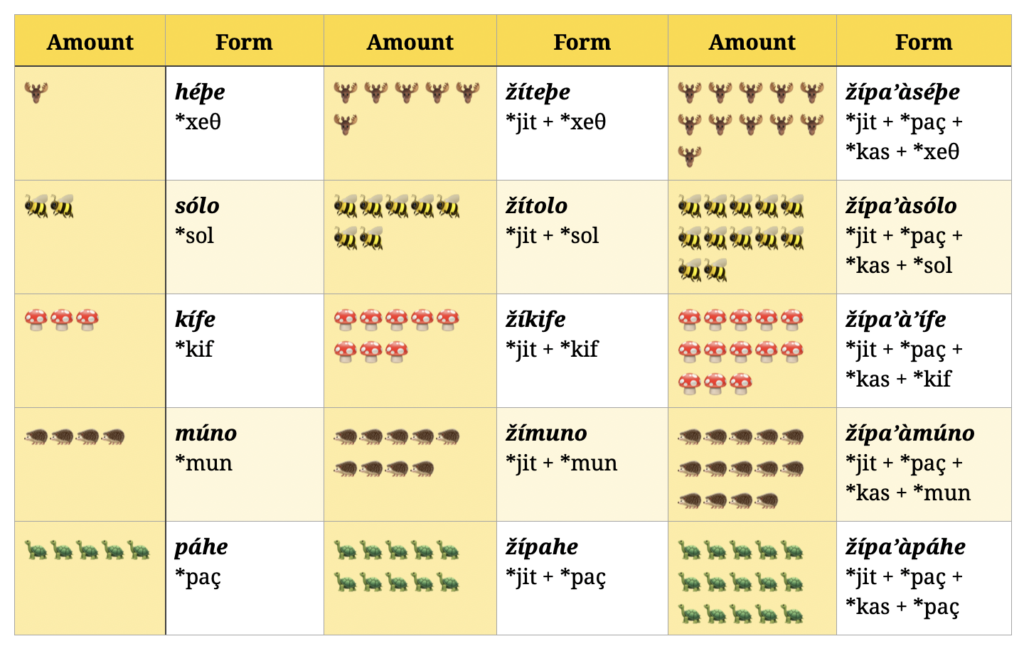I spent quite a bit of time figuring out numbers and how they work in Nómàk’óla (i.e. NisseLang). The nisse have a base-5 counting system. As a general practice, they count on one five-fingered hand (to keep the other hand free!), and as they count, they raise a finger. When they hit five, they put a finger back down to count from 6-10. The number forms are based on this practice, where 1-5 have distinct forms, and 6-10 come from “fold-one”, “fold-two”, and so on.
The numbers 11-20 are formed as a complex compound based on “fold-five”: “fold-five-add-one”, “fold-five-add-two” and so on all the way to “fold-five-add-fold-five.” After that, it flips to “two-pl-{fold-five}-add-one” for 20-24 until it reaches kváne, their concept of “hundred” (which is 52, or 25 in base-10).
The following table provides the cardinal number forms for 1-15, where the amount is represented by emoji (one emoji = one referent).

Using base-10 to refer to the amount of referents being counted, here is a simplified form of the table above:
| Amount | Form | Amount | Form | Amount | Form |
| 1 | héþe | 6 | žíteþe | 11 | žípa’àséþe |
| 2 | sólo | 7 | žítolo | 12 | žípa’àsólo |
| 3 | kífe | 8 | žíkife | 13 | žípa’à’ífe |
| 4 | múno | 9 | žímuno | 14 | žípa’àmúno |
| 5 | páhe | 10 | žípahe | 15 | žípa’àpáhe |
In the next table, a bird represents their concept of “hundred” (i.e. five-fives), an ant represents “thousand” (i.e. 53, or 125 in base-10), and a mosquito represents “ten thousand” (i.e. 54, or 625 in base-10), which is the largest numerical word form they assign any real value to. Curly brackets are placed around the emojis representing larger number values to indicate they are a conceptual group amount rather than a single entity. For each of the larger units, a single cell provides the form for “one, two, three, four” of those units before the next cell provides a specific example of combining that larger form with other numerical values. The larger compounds are too large to fit into a cell, so those words flow onto two or more lines.

Using base-10 to refer to the amount of referents being counted, here is a simplified form of the table above (the larger numbers definitely do not fit in these cells!):
| Amount | Form | Amount | Form | Amount | Form |
| 16 | žípa’àžíteþe | 21 | sólỳžípa’àséþe | 58 | sólỳkvánàžíkife |
| 17 | žípa’àžítolo | 22 | sólỳžípa’àsólo | 125 250 375 500 | únai sólèvúnai kífèvúnai múnèvúnai |
| 18 | žípa’àžíkife | 23 | sólỳžípa’à’ífe | 590 | múnèvúnai’àkífỳkvánàžípa’àpáhe |
| 19 | žípa’àžímuno | 24 | sólỳžípa’àmúno | 625 1250 1875 2500 | váúno sólỳváúno kífỳváúno múnỳváúno |
| 20 | žípa’àžípahe | 25 50 75 100 | kváne sólỳkváne kífỳkváne múnỳkváne | 1102 | váúnà’ífèvúnai’àmúnỳkvánàsólo |
When counting nouns (e.g. one bee, two bees), the cardinal number is followed by the linking particle è (which occurs between any head noun and a post-modifying constituent) and a plural noun form marked in the non-core object case. In other words, cardinal numbers occur in the head noun position and may be followed by a linking particle and non-core noun phrase to specify the referents being counted.
Þúja’óčàpásèšỳváti.
þúja-’ó-čà-pás-è-š-ỳ-váti
lived-I-near-five-LP-NCOBJ-PL-friend
“I lived near five (of my) friends.”
The cardinal number “five” is linked to and followed by a phrase indicating the particular referents being counted—in this case, friends. It is entirely grammatical to leave that information out:
Þúja’óčàpáhe.
þúja-’ó-čà-páhe
lived-I-near-five
“I lived near five (of them).”
Cardinal numbers are treated as nominal constituents.
This pattern of modification works for any number except “one”. When “one” is being used as a modifier, the quantifying modifier tú (“one, lone, sole”) is used rather than the cardinal number héþe “one”. Compare these examples:
Þúja’óčàhéþe.
þúja-’ó-čà-héþe
lived-I-near-one
“I lived near one (of them).”
Þúja’óčàlátitú.
þúja-’ó-čà-láti-tú
lived-I-near-friend-one
“I lived near one friend.”
The tú modifier is only used when a speaker is emphasizing that it is one and only one noun. Otherwise, the singular form indicates it is one referent, so it’s not necessary to indicate it is one noun. When the cardinal number is used as the head noun without specification, héþe “one” is used. (Also, the ordinal form vóseþe “first” is based on the cardinal form for “one”.)
Here are some examples of counting nouns in short phrases with the quantifier underlined:
- tváltú “one moose”
- sólèšèwéla “two bees”
- kífèšỳmólo “three mushrooms”
- múnèšèwísa “four hedgehogs”
- pásèšỳsí’a “five turtles”
- žíteþèšỳtvál “six moose”
The nisse tend not to use numbers unless it’s contextually important to know a precise number. The more generic quantifying modifiers tend to be used more frequently.
